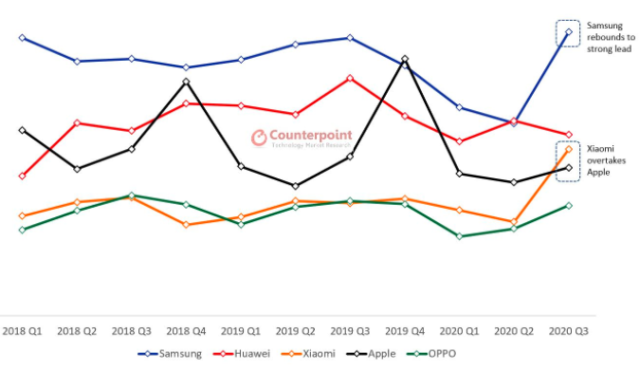The global smartphone market fell 4 percent year-on-year and grew 32 percent quarter-on-quarter to 366 million units in Q3 2020, according to Counterpoint report.

This recovery in smartphone business was driven by all key markets, like the US, India and Latin America, returning slowly to normal due to eased lockdown conditions. The report said the smartphone market has shown resilience to the ill effects of COVID-19 both from the supply and demand side.
“The supply issues are getting resolved as the manufacturing units in China and Vietnam have started operating at their normal levels, while in India, they are operating at 80 percent of the pre-COVID levels,” Tarun Pathak, associate director of Counterpoint, said.
Samsung regained the top spot, shipping 79.8 million units to register 47 percent QoQ and 2 percent YoY growth. This is the highest ever shipment by Samsung in the last three years.
The global smartphone lader has managed to recover in markets including India, Western Europe and LATAM, driven by new models like the Note 20 and from the A-series. A-series 5G SKUs showed solid uptake in the US.
In India, Samsung surpassed Xiaomi to become the No. 1 player, driven by the success of the M Series.
Huawei was the runner-up in the global market but showed a declining trend as its share dropped from 20 percent in Q2 2020 to 14 percent in Q3 2020.
Rapid growth of Realme continued during the quarter. Realme grew 132 percent QoQ in shipments volume, representing the strongest growth momentum among major global OEMs.
Xiaomi grew 75 percent QoQ to grab 13 percent share for the quarter. Notably, this was also the first time when Xiaomi surpassed Apple to capture the third spot.
Xiaomi reached its highest-ever shipments at 46.2 million units in Q3 2020. In China, Xiaomi’s struggle for growth ended and shipments were up 28 percent YoY and 35 percent QoQ.
5G shipments
5G shipments grew 82 percent QoQ driven by 5G devices quickly proliferating into the sub-$300 price band, with offerings from Huawei, vivo, OPPO, Xiaomi and OnePlus. Affordable 5G devices will drive this segment, especially in China, in the coming quarters.
Apple iPhone shipments declined 7 percent YoY during Q3 2020 as the company delayed its annual iPhone launch from Q3 to Q4. Apple’s performance will bounce back in Q4 2020 with the launch of the 5G-powered iPhone 12 series.
OnePlus grew 2 percent YoY and 96 percent QoQ driven by the strong performance of 8 series and the Nord in key markets like India and Western Europe.
Huawei drove more than 40 percent of the total 5G shipments, thanks to strong performance in China.
Motorola grew 37 percent QoQ and 4 percent YoY driven by strong performance in Latin America and the US-driven by the strong performance of E6 and G8 series.
Vivo has been performing well in overseas markets, especially in Southeast Asian countries like Indonesia and the Philippines, driven by its Y series.
OPPO is relying on operator partnerships to expand in European markets. OPPO is building partnerships with leading sports events to grow its influence across Europe.





